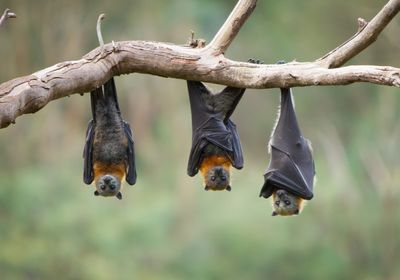ABOVE: © ISTOCK.COM, CRAIGRJD
Scientists in the US and Australia have laid out in detail the steps that cause Hendra virus, which causes a rare and sometimes deadly respiratory and neurological infection, to spillover into humans. Using a dataset that spans decades, the researchers demonstrated how climate change and deforestation have shifted the behavior of bats in Australia such that the animals spend more time in urban and agricultural settings when food is scarce, bringing them into proximity to intermediate hosts that can infect humans.
The findings are presented in a paper published in Nature yesterday (November 16). The authors write that the model they’ve built with the data can now predict future outbreaks up to two years in advance, and offer several suggestions for how to prevent them.
“It’s just an exceptional piece of work,” Cara Brook, a disease ecologist at the University of Chicago who did not participate in the study, tells The New York Times. “We actually have a rigorous, quantitative example of how land-use change impacts habitat for a wildlife species and accelerates zoonotic risk.”
Hendra virus was discovered in the 1990s, after horses at a farm in Brisbane began dying of a mysterious illness. Two men also began to suffer from flulike symptoms, one of whom, a horse trainer who had hand-fed a pregnant mare when she fell ill, died as a result, the Times reports. A subsequent investigation linked the deaths to a virus, later named Hendra virus after the suburb in which the farm was located, that could be found in the feces and saliva of flying foxes (Pteropus spp.). In the years since, and especially since 2003, there have been several additional outbreaks, leading to the deaths of hundreds of horses. Seven people have also been infected, and four have died.
The current study emerged out of a longstanding collaboration between Raina Plowright, an infectious disease ecologist at Cornell University, and Peggy Eby, a wildlife ecologist at the University of New South Wales, both of whom have spent decades studying flying foxes in Australia, the Times reports. Over the years, Eby has watched both the landscape and the bats change. Large swaths of the native eucalyptus forests where these bats prefer to feed—which flower throughout the year—have been lost to development and agriculture or stunted by climate change. In turn, the bats have been forced to adapt, trading their nomadic lifestyle, in which massive groups traveled from forest to forest seeking flower nectar, for one in which smaller groups forage over relatively small areas nearer to farms and gardens in urban areas. There, “it’s easier to eke out a living,” Plowright tells the Times. “You live next door to McDonald’s.”
See “Characteristics that Give Viruses Pandemic Potential”
Linking disease outbreaks to deforestation is not new; destruction of forest habitats has been implicated in epidemics of Ebola and malaria, among other diseases. However, pinning down exactly when, where, and why spillover occurs remains a challenge.
Plowright and her colleagues began sampling from a large population of bats around Brisbane in the early 2000s, looking to see how many were infected with Hendra. “And what we noticed is there was usually very little virus,” she tells NPR. “We often couldn’t find any virus at all within the population.” But when a cyclone off the coast in 2006 cratered the bats’ food supply, the number of animals plummeted. When Plowright sampled the blood of the few emaciated individuals she could find, they were teeming with the virus, likely because “they just don’t have enough energy to maintain an immune response to keep these viruses in check,” she tells NPR.
In an earlier paper published October 30 in Ecology Letters, some members of the same group teased apart these dynamics across three years of data, finding that outbreaks typically follow periods of climatic upheaval, particularly El Niño events, when the animals establish new roosts nearer to urban food supplies. The study also linked these events to increased viral shedding and to increased transmission from bats to horses.
See “Bat Coronaviruses May Infect Tens of Thousands of People Yearly”
The Nature study goes further, drawing on 25 years of data between 1996 and 2020. Among its findings, the study describes how the number of bat roosts has tripled since the early 2000s, while their available winter foraging habitat declined by one-third between 1996 and 2018. Often, this means that bats are settling in urban and agricultural areas, where they are more likely to encounter horses and people. The team’s models showed how food shortages typically follow El Niño events, which in turn induce more outbreaks over the following winters.
In 2018 and 2019, Australia experienced a strong El Niño followed by a drought. As a result, the researchers expected to see a corresponding bump in infections in 2020, especially as an intense wildfire season that year further reduced the food available to bats. There was at least one Hendra outbreak in May, but surprisingly, the surge never arrived. “Really everything told us that there was going to be a terrible cluster of spillover events of Hendra virus,” Plowright tells NPR. “So we were left scratching our heads.”
The group subsequently found that an unexpectedly massive flowering event of eucalyptus in the winter of 2020 drew as many as 200,000 bats away from human settlements and back to the forests. When the researchers added historical flowering events into their model, “we were just stunned,” Plowright says to NPR. “Whenever there was winter flowering, there was never a spillover case.” The studies conclude that when bats have a ready supply of food, they avoid urban and agricultural areas and spread Hendra virus to a lesser extent than they do in leaner years.
“It’s just an enormously impressive undertaking,” Aaron Bernstein, the interim director of the Center for Climate, Health and the Global Environment at the Harvard T.H. Chan School of Public Health, who was not involved in the research, tells the Times. “These scientists have essentially traced the dots across a bunch of the factors that we know can drive emerging infections.”
The results also suggest how scientists might approach mitigating these risks and minimizing spillover, with broader implications for other pathogens that enter humans from bats, such as Nipah virus, coronaviruses, and potentially Ebola virus. By restoring the habitats of animals that pose a spillover risk—and in this case, by planting trees that flower in the winter—“maybe we can prevent the next pandemic,” Plowright tells Nature.







